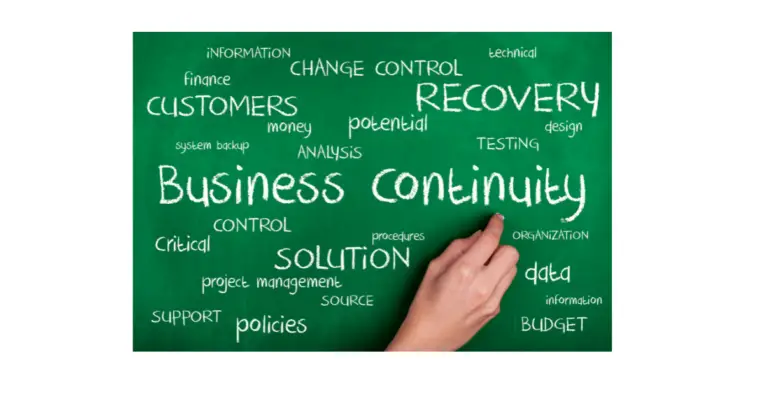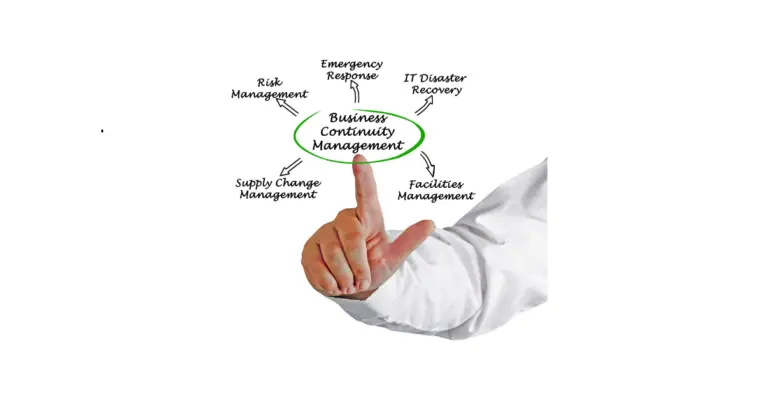¢what Are the Components of Developing a Business Continuity and Recovery Plans
Elements of business continuity attributed that there are always risks involved in running a company. From unexpected natural disasters to power outages, there are many potential threats that could disrupt the flow of business. That's why it's important to have a plan in place to ensure that your business can recover from any interruption +business continuance . This plan is known as a business continuity plan, and it typically includes four components of business continuity plan :
1) Identification of critical functions : The first step is to identify which functions are essential to the operation of your business. This will help you determine which areas need to be prioritized in the event of an interruption.
2) Development of contingency plans : Once you've identified the critical functions, you'll need to develop plans for how those functions can be maintained in the event of an interruption. This may include alternate work locations, backup power supplies, and other measures.
3) Implementation of risk management strategies : In addition to contingency plans, you'll also need to implement strategies to manage the risks that could disrupt your business. This may include insurance policies, safety protocols, and other measures.
4) Testing and review : Finally, it's important to regularly test your business continuity plan to ensure that it is effective. This may include simulations, audits, and other exercises.
There are four key components of business continuity: prevention , response , recovery , and testing . Prevention involves taking steps to reduce the likelihood of an interruption occurring in the first place. This might include hardening infrastructure against hurricanes or investing in redundant systems. Business continuity plan make up business continuity management framework.
+Business continuation
Business continuation planning is essential for any business, no matter how big or small. Key components of a business continuation plan include a detailed disaster recovery plan, an updated business continuity plan, and a well-funded emergency fund. Having these tools in place will help to minimize the impact of an unexpected event on your business and keep your company up and running.
+business continuity guidelines
Every business needs to have business continuity guidelines in place in case of an emergency. These guidelines help to ensure that the business can maintain its operations and minimize any disruptions. The first step is to identify the key components of the business that need to be maintained on +business continuity.
This includes critical functions, essential personnel, and vital data. Once these components have been identified, the next step is to develop plans for how they can be maintained during a disruption. This may involve developing alternate workflows, setting up redundant systems, or providing employees with additional training.
+business continuity framework
A business continuity framework is a set of policies, procedures, and processes that helps an organization prepare for and respond to disruptions. The goal of a business continuity framework is to minimize the impact of disruptions on operations and ensure that the organization can continue to function.+Business continuity solution by use of cloud based information technology systems.
A well-developed framework includes plans for how to maintain essential functions during and after a disruption, as well as procedures for restoring normal operations. The framework should be regularly reviewed and updated to ensure that it remains effective in meeting the needs of the organization.
+business continuity programs
Every company should have a business continuity program in place to ensure that they can continue operating in the event of an unexpected disaster. The key components of a business continuity program include a risk assessment, Business Impact Analysis, development of continuity plans, and testing and exercise of those plans.
A good business continuity program will identify the risks that could potentially impact the operation of the company and put in place plans to minimize the impact of those risks. The goal is to ensure that the company can continue to function even in the face of a major disruption. Testing and exercising the plans on a regular basis is essential to ensuring their effectiveness.
While no one likes to think about the possibility of a disaster, it is better to be prepared than to be caught off guard. A well-designed business continuity program can give a company the peace of mind knowing that they are prepared for whatever comes their way.+business continuity exercise is part of a business continuity program
critical business functions
A business's critical functions are the operations that must be carried out in order for the company to achieve its objectives. Typically, these functions are essential to the survival of the business and cannot be easily outsourced or replaced. For example, a retail business's critical functions might include managing inventory, processing payments, and providing customer service.
In contrast, non-critical functions are those that can be removed or outsourced without compromising the overall operation of the business. For instance, a company might outsource its marketing or accounting departments if it needs to cut costs. While critical and non-critical functions both play important roles in a business's success, it is typically the critical functions that have the greatest impact on the bottom line. Critical functions can be mitigated by +business continuity insurance.
recover critical business functions
Many businesses rely on their computer systems to recover critical business functions. In the event of a system outage, these businesses may be unable to continue operations until the system is repaired or replaced. To minimize the effects of an outage, businesses can take several steps to ensure that their systems are able to recover critical business functions.
One step is to create redundant systems that can take over if the primary system fails. Another step is to perform regular backups of data so that it can be restored in the event of an outage. Finally, businesses should test their recovery plans regularly to ensure that they will work as intended. +business continuity site can make arrangements during times of disruptions.
national fire protection association
The National Fire Protection Association (NFPA) is a standards-making and educational organization devoted to reducing fire hazards. Founded in 1896, the NFPA is best known for its development and publication of the National Fire Codes. These widely used codes cover every aspect of fire safety, from sprinkler systems to building construction. The NFPA also develops training materials and provides funding for research efforts related to fire prevention.
In addition, the organization works with government agencies, insurance companies, and others to promote fire safety awareness and advocate for effective laws and regulations. As the leading voice in fire protection, the NFPA plays a vital role in keeping people and property safe from the threat of fire.
what does a business continuity plan typically include
A typical business continuity plan includes a number of key elements. First, it outlines the steps that will be taken in the event of an interruption to normal operations.3 branches of business continuity include establishing a temporary work site, providing alternate transportation options, and setting up communication systems. Second, the plan outlines how the business will maintain critical functions during the disruption.
This may involve identifying which employees are essential to keep the business running, and making arrangements for them to work remotely or come in on a rotating basis. Finally, the plan outlines how the business will recover from the disruption and return to normal operations. This may involve making repairs to damaged infrastructure, restocking inventory, and providing counseling services to employees who have been affected by the event.
The response is the ability to quickly react to an interruption and minimize its impact. This might involve having a backup power generator or implementing a communication plan. Recovery is the process of getting operations up and running again after an interruption. This might involve restoring data from backups or setting up a temporary office. Testing is the practice of regularly simulating interruptions to ensure that the prevention, response, and recovery plans are effective.
The blog post will highlight and explains the elements of business continuity and its importance in today's business climate.

Identification of Critical Functions
The identification of critical functions is a key element of business continuity planning. The goal is to identify which functions are essential to the operation of the business and ensure that these functions can be carried out even in the event of an interruption.
To identify critical functions, businesses need to first assess their operations and determine which activities are necessary for survival. This can be done by conducting a business impact analysis, which identifies which functions are most important to the business and what would happen if they were disrupted.
Once critical functions have been identified, businesses can develop plans to ensure that these functions can continue to be carried out even in the face of an interruption. This may involve developing alternative methods for carrying out the function, procuring backup supplies, or establishing alternate work locations.
Another approach involves a review of the organization's overall mission and objectives. From there, each individual department or business unit is assessed to determine which functions are essential to its operation. Once the critical functions have been identified, businesses can develop continuity plans that address how those functions will be maintained in the event of an interruption.

Importance of Identification of Critical Functions
- It is important to identify critical functions in order to protect them during a crisis.
- Critical functions are those that are essential to the continued operation of the business.
- Without critical functions, the business would not be able to survive.
- Identifying critical functions can help you focus your resources during a crisis and ensure that the business remains operational.
- By definition, critical functions cannot be outsourced or replaced.
Development of Contingency Plans
Many organizations develop contingency plans as part of their business continuity efforts. A contingency plan is a document that outlines how an organization will continue to operate in the event of an unexpected interruption. The development of a contingency plan is part of business continuity planning.
The goal of a contingency plan is to minimize the disruption to operations and ensure that essential functions can continue. Contingency plans typically address issues such as backup power, communication, and transportation.
They may also include provisions for contingencies such as extreme weather events or pandemics. While developing a contingency plan can be expensive and time-consuming, it can ultimately save an organization significant resources in the event of a major disruption.
Contingency plans are developed in consultation with risk management professionals, who will assess the likelihood of various risks and help to create a plan that will minimize the impact of these risks. The contingency plan should include a description of the steps that will be taken in the event of a risk, as well as how the business will recover from the impact of the risk.

Benefits of contingency plans
- A well-thought-out contingency plan can help a company to minimize disruptions and continue operations in the event of a disaster or other emergency.
- By having a plan in place, a company can reduce its vulnerability to risks and protect its employees, customers, and business interests.
- A contingency plan should be tailored to the specific needs of the company and should include detailed procedures for dealing with a range of possible emergencies.
- The plan should also identify key personnel who will be responsible for carrying out the various aspects of the plan.
- Having a contingency plan in place can help to instill confidence in employees and customers that the company is prepared for any eventuality.
Implementation of Risk Management Strategies
Implementing Risk Management Strategies is important for business continuity. By their very nature, business continuity and risk management strategies are closely intertwined. business continuity planning (BCP) deals with the creation of systems and processes that will keep a business running in the event of an emergency, while risk management is the process of identifying, assessing, and mitigating risks to an organization.
As such, the Implementation of Risk Management Strategies should be an integral part of any business continuity plan. By identifying risks early and putting systems and processes in place to mitigate them, organizations can ensure that they are able to keep operating even in the face of unexpected challenges.
In today's increasingly uncertain world, Implementing Risk Management Strategies is more important than ever for businesses that want to stay ahead of the curve. A comprehensive Risk Management Strategy will consider all potential risks to the business, including those that could result in Business Continuity interruptions.
There are three essential elements to a successful Business Continuity strategy:
- Risk Identification and Assessment – The first step is to identify all potential risks to the business, including those that could result in Business Continuity interruptions. This step will help you prioritize the risks and develop a plan to address them.
- Business Impact Analysis – Once all potential risks have been identified, it is important to assess the impact that each one could have on the business. This step will help you determine which risks are most likely to occur and how they could affect the business.
- Business Continuity Planning – The final step is to develop a plan to address the risks that have been identified. This plan should include steps to mitigate the impact of the risks and ensure that the business can continue to operate in the event of an interruption.
Importance of Implementing Risk Management Strategies in business continuity
- Effective risk management is essential to business continuity and resilience planning.
- Risks can come from a variety of sources, including natural disasters, human error, and malicious activity.
- There are a variety of risk management strategies that can be used to mitigate the impact of risks on an organization.
- It is important to tailor risk management strategies to the specific needs of each organization.
Testing and Review
Testing and review are crucial elements in business continuity planning, as they help to identify potential weaknesses and develop strategies for addressing them. Reviewing business processes and procedures on a regular basis helps to ensure that they are up to date and effective.
Testing business continuity plans helps to identify any areas that need improvement. By testing and reviewing business continuity plans on a regular basis, businesses can be better prepared to deal with disruptive events.
One key element of a successful BCP is testing and review. Businesses can identify potential weaknesses and take steps to address them.
Additionally, review meetings provide an opportunity for all stakeholders to assess the effectiveness of the Plan and make necessary revisions. Through incorporating testing and review into the business continuity planning process, businesses can ensure that their plans are up to date and effective.
- Review organizational objectives
- Review and update business continuity strategies
- Conduct regular testing and review of the plan
Importance of testing and review
- Testing and reviews are important in business continuity because they help ensure that plans are effective and can be executed correctly in an emergency.
- Testing helps to identify potential problems and areas for improvement, while reviews help to ensure that updated information is reflected in continuity plans.
- Both testing and reviews should be conducted on a regular basis to ensure that plans remain up-to-date.
Conclusion
The 3 Elements of Business Continuity are the Identification of critical functions, the Development of contingency plans, and the implementation of risk management strategies. By taking these steps, you can help ensure that your business will be able to continue operating in the event of an unexpected interruption. Have you put a plan in place for your business? If not, now is the time to start.
mcleriepainarompat.blogspot.com
Source: https://riskpublishing.com/what-are-the-3-elements-of-business-continuity/